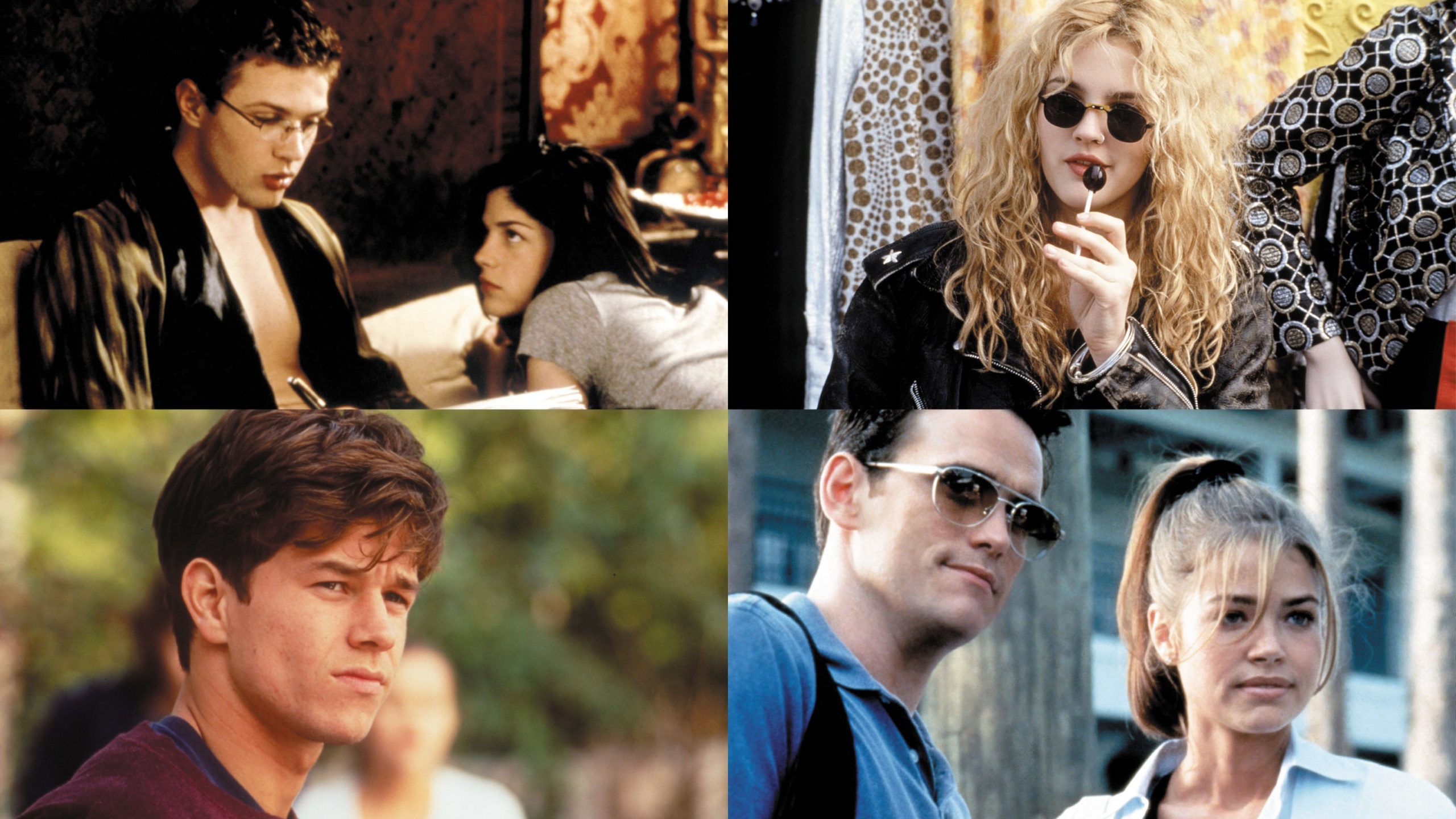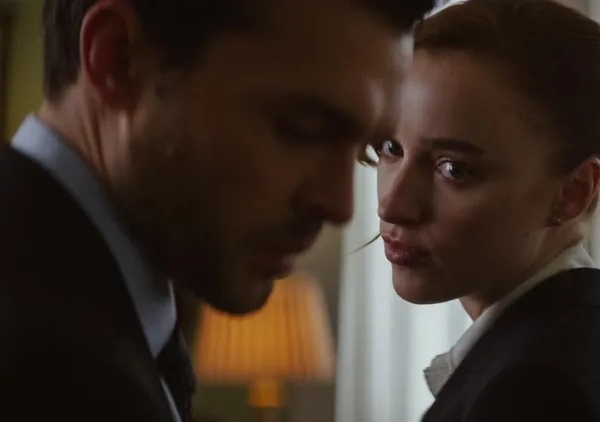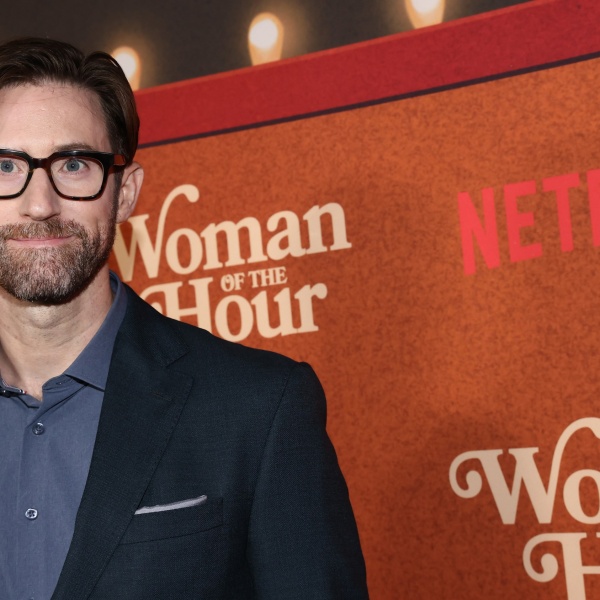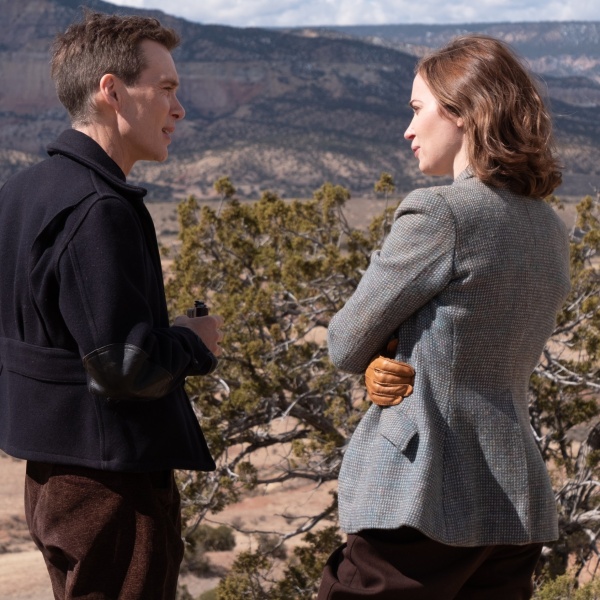What’s more dangerous than a teenage girl? Sexualizing one.
The fear of newfound sexual freedom, particularly the libidos of adolescent girls, were interrogated, explored, and — at times — exploited in ’90s-era high school-set psychosexual thrillers. From the age of characters portrayed, actors’ requests for body doubles, or the questionably problematic market for watching real-life teens undress onscreen, the eroticism of teens in the ’90s still has resonance today.
Now, as Todd Haynes’ “May December” shows the lasting psychological effects of the traumatic grooming of a male tween (Charles Melton), and Yorgos Lanthimos’ “Poor Things” charts a sexual awakening from a developing child mind in an adult body (played by Emma Stone), it’s only right to return to the trend of coming-of-age sexuality onscreen, most infamously weaponized by a niche genre trend of thrillers framed by teen female perpetrators.
Sex is back onscreen, but what did overt eroticism look like in films past?
Hollywood in the ’90s has been tainted in retrospect, as the culture has grappled with what the rise of Harvey Weinstein as a mega-producer really meant, along with studios pushing for more sex and more nudity from younger and younger stars. But were these teen films for high school theater-goers, or leering adults? And even worse, did studios even care so long as tickets were sold?
“Crush,” “Wild Things,” “Fear,” “Cruel Intentions,” and “Poison Ivy” each offered iconic portrayals of young femme fatales onscreen that marked the cornerstone of the erotic thriller trend for adolescents, whether intentional or not.
“Crush”
“How come I don’t see any tits?”

The 1992 film “Crush,” starring a 15-year-old Alicia Silverstone, was told from the perspective of magazine writer Nick (Cary Elwes), who is renting a house from a couple whose 14-year-old daughter Adrian (Silverstone) attempts to seduce him — with sinister, obsessive consequences. Adrian sets out to ruin Nick’s life, just as he falls for an (adult) colleague (Jennifer Rubin).
“Crush” was written and directed by Alan Shapiro, who told IndieWire that his initial “tongue-in-cheek” concept was thwarted by studio Warner Bros. “They thought, what I think a lot of people did, was that it was just a teenage thriller,” Shapiro said. “But to me, it was tongue-in-cheek, totally. I always saw her as sort of a teenage Gloria Swanson kind of character. It was like a satire to me, but they didn’t let me do that. I tried to do it as best I could, but they wanted thriller.”
“Crush” was marketed as the teen “Fatal Attraction” and, according to Shapiro, the studio pushed for more (underage) sexually suggestive scenes and nudity.
“There’s a scene where Cary Elwes is in the closet looking out at her [Silverstone] getting dressed and she turns around and lets her shirt drop.I got a call the next day from the studio saying, what is wrong with me? ‘How come I don’t see any tits?,’” Shapiro said. “So I said, ‘Well, I didn’t really want to do that.’ And they insisted on hiring a model for Alicia and showing her breasts. And we did. We shot it but I was able to cut it out. There’s another shot they made me use the double when it’s his point of view from her bedroom and she’s looking at her going into the bathroom, naked, and we can see her back with her butt. The butt was the biggest reveal that we could do.”
He continued, “It all revolved around sex. They wanted as much sex as possible from Alicia. I mean, obviously, it wasn’t a porno, but they wanted it as titillating as possible. She kind of went for that. She got it. This is 1992; this is pre-#MeToo. It was like they could have said anything. I mean, the law prohibited them from shooting a minor but they would have if it wasn’t illegal. Also, we were in Canada, but I don’t think that really made a difference.”

He added, “Now you look back, I mean, she was 15. She turned 16 in the middle of the shoot, but still it was very ridiculous.”
Shapiro credited the popularity of “Single White Female” and “The Hand That Rocks the Cradle” (also both from 1992) for pushing the genre of a “teenage girl from Hell.” In fact, the spec script for “Crush” incited a bidding war between studios before landing at Warner Bros. Production was fast-tracked and the film was released less than a year after the script was bought. The film grossed $13.6 million at the box office against a $6 million budget.
Shapiro pointed to the marketing campaign envisioned by Warner Bros. for “Crush”: “My sense was they wanted a film that could be talked about and get people buzzing about it because they had a certain position,” he said. “Once Alicia was cast, they started reacting to the dailies and how she was fantastic. And they thought, ‘Oh God, she could give us more of whatever,’ and then that those calls from L.A. would come in.”
Lead actress Silverstone told Interview in 1994 that she did not have a chaperone on set, saying that it “worked better for my character without one.” Silverstone said that she “envied the power” her character Adrian wielded at age 14 in the film.
“I loved being able to walk on the set as Adrian and think that everyone there was hot for me. I would never feel that way in life,” Silverstone said at the time. “I decided that if she’s going to just be a tough girl, you can’t love her. You can only want her physically. But I wanted to make her a real, whole human being. … I wish I could go back and do the movie again, because it isn’t often that a young girl can be really aggressive and take over the whole movie.”
Writer-director Shapiro said the “Lolita” element of “Crush” led to him getting letters calling him a “pedophile” upon the film’s release. Now, Shapiro is aware of the “cult following” for “Crush,” referencing how the newfound fandom decades later is closer to his initial pitch for the film in general.
“I certainly never intended it to be a down-the-middle scary movie because it’s not scary at all, and it was never intended to be. It’s not even thrilling; I just thought it was funny,” Shapiro said. “I was trying to do a sort of a black comedy on those genres, but clearly I failed, or it is just kind of the timing of it.”
“Wild Things”
“You want sex, you want violence, here you go.”

“Wild Things,” which celebrated its 25th anniversary this year, is also a satirical dark comedy, directed by John McNaughton. The 1998 film follows a guidance counselor (Matt Dillon), who is accused of rape by a preppy popular girl (Denise Richards) and a wrong-side-of-the-tracks teen (Neve Campbell). It turns out that the rape charge was a fake shakedown for a cash settlement, and twists abound — including a later consensual threesome and a few unexpected murders.
Director McNaughton told IndieWire that the target audience for “Wild Things” was, well, himself. “I made a movie that I would like to see. The idea that I needed to make a commercial film in those days, I went, ‘OK, what sells? You want sex, you want violence, here you go, more than you can swallow,’” McNaughton said. “It was just to make a movie that broke the rules, a movie that was transgressive. It wasn’t just meant to be a teen candy cane movie.”
McNaughton pointed to how grounded in the “real world” the script was, while still serving as somewhat of a spoof of teen thriller films themselves. “It was intended to be a believable story,” he said. And the basic premise of “Wild Things” (sans twists) is believable because, well, it happened to the film’s screenwriter.
Scribe Stephen Peters told The Independent that the concept for the mock erotic thriller was based on an actual encounter with two teenage girls during a door-to-door car washing fundraiser. “I told them to step inside for a second and shut the door,” Peters recalled of interacting with the two girls. “I found my wallet, paid them and they left. I stopped and thought, I was in a situation where these two girls could say anything about me.”
The paranoia of the power wielded by beautiful young women inspired “Wild Things,” like a “Basic Instinct” for the high school halls. By the mid-’90s, erotic thrillers with adult characters, marketed to adult audiences, were losing their luster. “Sliver,” screenwriter Joe Eszterhas’ follow-up to “Basic Instinct” also starring Sharon Stone, was a box office and critical flop. Yet teenagers were ripe for warnings on just how dangerous budding female sexuality could be, especially during adolescence and when adult men are the targets of seduction.
“My notion was how to portray sexual power,” “Wild Things” screenwriter Peters said. “They were very powerful girls because they knew what effect they had. It was another trick in the story — it looks like they’re being exploited, but they’re doing the exploiting.”

McNaughton added that “Wild Things” was driven by a “political statement” about the “underdog” character, played by Campbell. “It was topsy-turvy, turning the whole political structure and social structure upside down,” McNaughton said. “I always like to push ahead of the boundaries of good taste or acceptability.”
McNaughton admitted that he “resents” the reviews calling the film “sleazy” or “trash” upon release. “It’s like the idea that this movie was intended to be a piece of shit, but accidentally turned out to be a good movie. Nothing could be further from the truth,” McNaughton said. “The tone, as I look at it, reminds me a lot of John Waters films. The idea was to tell that story in a believable way and with a certain sense of style and a certain sense of irony.”
In the 25 years since the film’s release, “Wild Things” has been heralded as a “feminist statement” onscreen, something that McNaughton agrees with while admitting that wasn’t the intent at the time.
“When the film was first released, there wasn’t a lot of laughterbecause it was shocking,” McNaughton recalled. “But it was funny, 25 years later, it was a comedy.”

“Wild Things” was pitted against James Cameron’s “Titanic” upon release, a scheduling choice for a would-be summer blockbuster in the winter months that McNaughton claimed was due to Sony shipping anything Mandalay producer Peter Guber developed after Guber parted ways with the company. The film grossed $67.2 million at the box office against a $20 million budget, something that McNaughton claims could have reached even higher heights.
Part of “Wild Things” cult fandom is the chemistry between lead stars Campbell and Richards, with the film propelling both actresses’ careers. “Party of Five” star Campbell was originally approached to play the good girl cheerleader role, which later went to Richards after Campbell turned it down.
Due to Campbell’s TV contract, she had a no-nudity clause. Richards, meanwhile, negotiated how much she would strip down on camera.
“I’ve always found that it’s, ‘How many buttons will we unbutton?’ I mean, it gets down to the most pinky,” McNaughton said. “And then comes the day: If you treated the actors well and you haven’t pulled any fast ones on them, I say, ‘Oh, well, would you take your shirt off in the scene?’ ‘Well, it’s not in the script.’ To me, you always have to read the script. We’re going to do just exactly what it says on this page, no more, no less. I hold you to it, you hold me to it. And so on the day, if it says you do such and such, then you agree to do that. I agree not to ask for more than what’s on the page.”
McNaughton continued, “So coming up to the big sex scenes, there’s always a lot of tension and people get cranky and worried, but if people have been treated well and things are going OK socially amongst the cast, crew, director, actor, relationships, etc., then so often once the scene gets rolling, the actors will go further. They’ll want to go further once they’re into what the scene’s about. And that’s sort of what happened.”
He added, “I know in the pool scene that Neve and Denise, both were in their trailers drinking margaritas ahead of time. And by the time they got on set, they were ready to go.”

But the other hotel sex scene was a “tough day” coming off of a 22-hour shoot for the courtroom scene with Matt Dillon’s character. The sensual scene was filmed in an “old warehouse converted to a studio where they used to shoot ‘Flipper,’” according to McNaughton, and the humidity was almost unbearable.
“Everyone was a little burned out,” he said. “It was one of the most uncomfortable days of my life. For actors to pretend to have sex in front of however many crew members you allow on the set, I can’t think of a more uncomfortable way to spend a few hours, pretending to have sex, half-clothed in front of strangers on a set with lights, cameras, gear everywhere. But we got through it and Jeffrey Kimball, the cinematographer. … No one could make women look more beautiful than Jeffrey could and he just nailed it.”
Actress Richards, who negotiated in her contract over which nipple she would show on-camera, recently told The Guardian that it was “terrifying” to film her nude scenes. “It was the first time I had filmed anything like that, so I was obviously extremely nervous,” Richards said. “There are a couple of scenes that are very risqué. There’s a lot of choreography of figuring out who’s going where, so it’s not as sexy as people think. I’m sure people must think that behind the scenes it’s very exciting, but it’s not. But I’m glad it comes off that sexy in the movie.”
Richards had filmed “Starship Troopers,” directed by “Basic Instinct” helmer Paul Verhoeven, the year prior to “Wild Things.” Richards told The Guardian that she had “refused” to film a topless scene that Verhoeven added that was not in the original script. Richards has not publicly spoken about whether her experience on the film led to her negotiations over nudity with “Wild Things.”
“Fear”
A “formative” film, both onscreen and off.

The community atmosphere McNoughton described on “Wild Things” did not extend to every film that fell under the “sex sells” teen genre in the ’90s. Reese Witherspoon recently made headlines for opening up about her lack of “control” over her nudity in 1996’s “Fear,” directed by James Foley. The film made $20.8 million at the box office.
Witherspoon was 19 when filming the infamous rollercoaster scene in which her character is digitally penetrated by a sinister love interest (Mark Wahlberg). Witherspoon noted that she requested a stunt double for the below-the-waist scenes, but ended up shooting them herself.
“I didn’t have control over it,” Witherspoon told Harper’s Bazaar. “It wasn’t explicit in the script that that’s what was going to happen, so that was something that I think the director thought of on his own and then asked me on set if I would do it, and I said no. It wasn’t a particularly great experience.”
The Hello Sunshine producer added, “I’m certainly not traumatized or anything by it, but it was formative. It made me understand where my place was in the pecking order of filmmaking. I think it’s another one of those stories that made me want to be an agent for change and someone who maybe can be in a better leadership position to tell stories from a female perspective instead of from the male gaze.”
“Poison Ivy”
A “regretful” heroine is born.

In contrast, 1992’s “Poison Ivy,” directed by Roger Corman alum (and female filmmaker) Katt Shea, capitalized on lead actress Drew Barrymore’s “baggage,” as Shea told Yahoo! recently. Barrymore was 16 years old at the time of production, and she had previously been to rehab for drug and alcohol addiction at age 13; the child star was legally emancipated from her parents by age 14.
In “Poison Ivy,” Barrymore’s character seduces her friend’s father (Tom Skerritt), who was in his fifties at the time. Skerritt allegedly told director Shea that he was hesitant to film the intimate sequences with teen star Barrymore.
“[Drew] was just like, ‘Oh boy, let’s do it!’ Meanwhile, Tom is going, ‘Oh my God, oh my God.’ His discomfort is so palpable in the film,” Shea recalled, noting that “Poison Ivy” was viewed as Barrymore’s chance to shed her child star image.
Studio New Line wanted an NC-17 version, similar to Warner Bros.’ push for “Crush” to have more nudity; an unrated cut is available on the “Poison Ivy” DVD.
“I hate that stuff because they’re just throwing in the kitchen sink. Everything that we needed in the movie was there, and I thought the other stuff was kind of unnecessary,” Shea said. “I didn’t want to include it just for titillation.”

Per Shea, “Poison Ivy” is also based on executive producer Melissa Goddard’s real-life experience, much like how “Wild Things” was inspired by the screenwriter’s encounter with teen girls. Shea reflected on the aspirational fandom of Ivy, with audiences perceiving her as a martyr and not a homewrecker.
“A lot of people take it that way, which I regret,” Shea said. “I didn’t intend for girls to make her a role model. So that’s why I don’t make movies like that anymore. I think it was misinterpreted.”
She added, “I don’t think that movie would be made today, period.”
“Cruel Intentions”
Erotic thriller goes to boarding school, with a high-brow reception.

Is the visceral response from female viewers to “Poison Ivy” empowering or problematic? Does the subversion of an innocent teen seducing an older man and acting the part of a femme fatale accurately represent the coming-of-age journey for women? And how many teens are thinking that adult men are watching these films through an entirely different lens?
The female gaze, queer film “Cruel Intentions” made the inner workings of elite high schoolers a game to be won; a virgin (Selma Blair) was fresh meat for the taking, as audiences watched Kathryn (Sarah Michelle Gellar) seduce her stepbrother Sebastian’s (Ryan Phillippe) prey to foil his bet while he actually falls for Annette (Reese Witherspoon). The 1999 indie film was an adaptation of the 1782 novel “Les Liaisons Dangereuses,” and became an iconic kinky cult classic with a twist ending that champions sexual freedom and female empowerment.
The cult fandom of “Cruel Intentions” was unparalleled to the more niche B-movie adoration for “Poison Ivy,” and arguably offered a better, more moralistic ending: the good girl gets away, the bad man dies, and the school slut’s social reign is over.
So, What Now?
Much like the ’70s and ’80s obsession with erotic thrillers, the insatiable quality of offering a ’90s twist on the genre by lowering the age of its core characters faded out by the early 2000s. Instead, teen-centric films were offered with a more upbeat play, capitalizing on the literary updates made famous by 1995’s “Clueless” and later leading to “10 Things I Hate About You,” “She’s the Man,” and more. The trend of “Lolita”-esque seductress roles threatening adult mens’ livelihoods by way of temptation fell by the wayside, and were deemed schlock once more instead of box office gold.
Lifetime cable made-for-TV movies instead became the outlet for teen erotic thrillers, with the evil babysitter/cheerleader/insert teen stereotype being the threatening force disrupting the domestic bliss of a happily married couple. The sexualized teen was no longer an out-of-control mysterious figure turned heroine like “Poison Ivy”; instead, the pre-Code ethics of the sexually promiscuous woman being punished by death or jail time or a psych ward returned via the small screen.
As the rise of erotic thrillers geared toward adults are now returning to theaters, from Adrian Lyne’s “Deep Water” to Chloe Domont’s “Fair Play,” will teen erotic thrillers inevitably come back into fashion once more?

“What Comes Around,” released in early 2023, incorporated the questionable ethics of a gender-swapped #MeToo story, something that has now been seen in Catherine Breillat’s “Last Summer” and Todd Haynes’ “May December” as well with young male victims at the center of the story.
“What Comes Around,” though, acts as a bridge between Lifetime and indie films; the feature is arguably more in line with the campiness of ’90s teen erotic thrillers, but has a modern message from a female filmmaker who told IndieWire she was intentional to not exploit the concept of teen sex for audience titillation. The film follows a mother-daughter love triangle, with an alleged rape victim (Kyle Gallner) trying to frame his former teacher (Summer Phoenix) for assault by grooming her teen daughter (Grace Van Dien).
Director Amy Redford told IndieWire that the thriller, based on Scott Orkin’s play, is a “Trojan horse” vehicle to remind audiences that “binary thinking” is the real danger, not the sexual awakening of teens.
“It was intentional that we are not sort of getting off on watching these two,” Redford said of the intimate scenes involving Van Dien and Gallner’s characters. “We’ve all done the mental gymnastics asking, ‘Is that a good thing that we’re eroticizing the brutal murder of young teenage girls?’ I think that’s it not necessary [to sexualize teen stars]. I think it was a little bit of a hack to get people to have the sensation of fear or be in a heightened emotional state. And it turns out we can do that in all kinds of ways.”
Redford, the daughter of Sundance founder and acclaimed writer/director/star Robert Redford, continued, “The evolving of filmmaking and the permission to put in some of those deeper themes allowed it to not just lean on a few different devices. I think also just the ways in which we understand where the cost is, if we give permission for lack of consent in some way or another.”
And 30 years later, we’re still culturally taking stock of the lasting costs of studios promoting promiscuity as being dangerous and yet still something to gaze upon. These teen girls in ’90s thrillers just love being bad, and audiences flocked to see just how “gone wild” they became in the suffocating social norms of adolescence. Doesn’t it say more than these teens wanted to take control of their own lives by way of predatory sex and violence onscreen, than the campiness of the films themselves?
In the three decades since the 1990s, films like “Spring Breakers,” “Jennifer’s Body,” and “Thirteen” have instead morphed the sex positivity of teens onscreen into statements about body autonomy and consent rather than being salacious for the sake of selling tickets.
But with a remake of “Fear” in the works as of 2018 at Universal Pictures, perhaps the return of teen erotic thrillers is on the horizon. It’s still a dangerous game to ask which came first, though: the eroticization of young women, or the misunderstanding of them.





